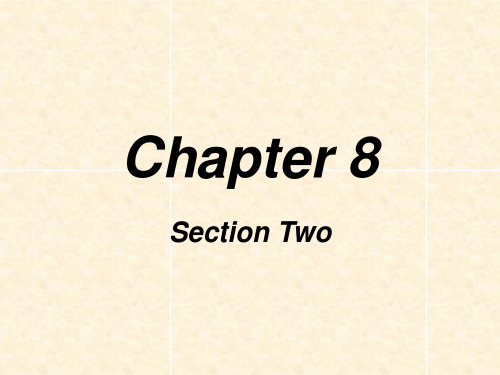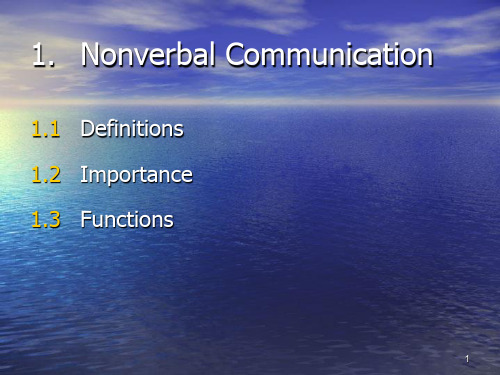跨文化交际-黑龙江大学-崔常亮老师-chapter1-2分析
- 格式:ppt
- 大小:1.71 MB
- 文档页数:23


⿊龙江⼤学跨⽂化课后checklistCHECKLISTChapter 1Fill in BlanksCulture : is the deposit of knowledge, experience, belief, values, actions, attitudes, hierarchies, religions, not ions of time, roles, spatial relations, concepts of the universe, and artifacts acquired by a group of people in t he course of generations through individual and group striving.Subculture:refers to a culture that exists within dominant culture, and is often based on economic or social class, ethnicity, race, or geographic region.Subgroup: usually does not involve the same large number of people and is not necessarily thought of as acc umulating values and patterns of behavior over generations in the same way as cultures do.Culture Identity: refers to one’s sense of belonging to a particular culture or ethnic group.2 判断对错TRUE:1 The ice burger model of culture implies that it is very difficult to understand a culture thoroughly.2 People may sometimes get confused about his or her culture identity.3 A person could be a member of several different subgroups at the same time.Wrong:1 Culture is innate as soon as a person is born.2 Scholars prefer the term subcultuer to co-culture in describing a culture which exists within a dominate culture. Chapter 21 Fill in BlanksSender refers to the person who transmits a message.Channel (sometimes called the medium) is the method used to deliver a message.receiver is any person who notices and gives some meaning to a message.International communication is communication between people whose culture perception and symbol system are distinct enough to alter the communication event.2 判断对错TRUE:1 Communication and culture are inseparable and strongly connected.2 The process of communication has nine components: sender encoding message channel noise receiver decoding feedback and context.Wrong:1 Intracultural communication occurs when the sender and the receiver exchanging messages are from different races.2 The sender must choose certain words or nonverbal methods to send an intentional message. This activity is called decoding.Chapter 41 Fill in BlanksEthnocentrism:refers to negatively judging aspects of another culture by the standards of one’s own culture Prejudice: It refers to the irrational dislike, suspicion, or hatred of a particular group, race, religion, or sexual orientationRacism: It refers to any policy, practice, belief, or attitude that attributes characteristics or status to individua ls based on their raceStereotypes: They refer to negative or positive judgments made about individuals based on any observable or believed group membership2 判断对错TRUE:1 Ethnocentrism stereotypes prejudice and racism are learned.2 Although stereotypes are considered as being negative judgments,they can also be positive.3 When communicating with people other cultures,an individual sometimes is likely to treat them as“his people”and to assume there is only one way of doing things: that is “his way”Wrong:1 Assumption of superiority may lead to assuming similarity instead of difference.2 Economy is not the reason for the persistence of ethnocentrism, stereotyping, prejudice and racism.Chapter 51 Fill in BlanksVerbal intercultural communication happens when people from different cultural backgrounds communica te with each other by using language.Pidgin is a special language variety that mixes or lends languages for restricted purposes such as trading Dialect is a form of language peculiar to a group of people, as distinguished from the literary language of the whole people.Taboo refers to prohibition of a set of behaviors that should be avoided because they are offensive and impol ite2 判断对错TRUE:1 The elaborate,exacting,or succinct communication style deals with the quantity and/or volume of talk that is preferred across cultural groups.2 Dialect refers to geographic variation, while sociolect refers to variation in terms of social group.3 An elaborate style of communication can be seen in Arab cultures.Wrong:1 The exacting style of communication can be found in Japan,China,and some Native American cultures2 The self-effacement verbal styles emphasizes the importance of boasting about one’s accomplishments and abilities. Chapter 61 Fill in Blanksnonverbal communication: It refers to the messages sent without using words.Oculesics: It is the study of communications sent by the eyes.Proxemics: is the way we use fixed space and personal space.Kinesics includes gestures, body movement and facial expressionsChronemics: It is the study of how people perceive and use time.2 判断对错TRUE:1 Saudi Arabs belong to touch cultures.2 The appropriateness of eye contact varies with different cultures.Wrong:1 Speaking is the only mode of effective communication.2 The Thais like to touch babies or small children,especially they like others to pat their children’s head.3 Paralanguage may imply the connotation of the actual words.Chapter 71 Fill in Blanks1 Members in the culture of high Uncertainty avoidance have a lower tolerance for uncertain and ambiguity.2 Individuals from high power distance accept power as part of society.As a result,superiors consider their subordinates to be different from themselves and vice versa.3 People from high masculine cultures tend to see same-sex relationships as more intimate than opposite-sex relationships.4 In collective societies such as those in Pakistan,Colombia,Venezuela,China and Peru people are born into extended families that support and protect them in exchange for their loyalty.2 判断对错TRUE:1 In industrialized societies like the United States,the mastery-over-nature view tends to predominate.2 A doing orientation involved in focus on those types of activities which have outcomes that can be measured by someone else.3 In Beijing cultures,social status and position are more important than what a person does.Wrong:1 The harmony-with-nature orientation draws clear distinctions among human life,nature,and the supernature2 Both Americans and British shoe respect for tradition.Chapter 81 Fill in Blanks1 In Japan ,business is not conducted in obon (in mid-August),because many people travel to the graves of their ancestors.2 In India ,“the traditional greeting is the namaste formed by pressing the palms together,fingers up,below the chin.A slight bow may be added to show respect.”3 In Israel,the Jewish holy night, the sabbath begins at sunset on Friday and ends at sunset onSaturday.Therefore, the business week runs from Saturday through Thursday.Conducting business on the holy day would be highly inappropriate.4 In Saudi Arabia. No business is conduced during the three-day festival of breaking fast at the end of the month of Ramadan.2 判断对错TRUE:1 In Finland, firm handshakes are the normal greeting for men and women.2 Americans might regard gift giving as a form of bribery.3 Mexican negotiators emphasize relational concerns prior to the real negotiation.Wrong:1 In Saudi Arabia,the greeting tend to be informal.Both men and women shake hands on meeting and leaving.2 In Japan,one should open the gift in front of the giver.Chapter 91 Fill in BlanksHoneymoon is the first stage of the interculture adaptation when everything is new and exciting. Segregation occurs because the more politically and economically powerful culture does not want the interc ultural contact with the immigrants Integration: is desire a high level of interaction with the host culture while maintaining identity wit h their native culture Assimilation is a process in which members of an ethnic group are absorbed into the dominant culture, losin g their culture in the process.Marginalization occurs when the individual chooses not to identify with his or her native culture or with the host culture.2 判断对错TRUE:1 Successful management of culture shock depends on an awareness of its symptoms and the degree of its severity.2 Financial matters can results in culture shock.Wrong:1 Similarity of culture does not affect acculturation.2 The second stage of interculture adaptation is called honeymoon stage or initial euphoria stage.3 All the activities of learning one’s culture are called acculturation.4 Insomnia can be one example of the physical symptoms of culture shock,。


跨文化交际学概论笔记----f334b180-7164-11ec-82d6-7cb59b590d7d第一章跨文化交际一、什么是跨文化交流——不同文化背景的人进行交流的过程。
今天,跨文化交际越来越受到人们的关注,主要原因是由于交通的进步和交际手段的发展,来自不同国家、种族和民族的人们可以频繁地接触和交流。
l、哈姆斯认为,世界上的交流经历了五个阶段:语言的浮现;用词;印刷技术的发明;近百年来交通工具的进步和通讯工具的快速发展;跨文化交流。
在过去的二十年里,交流的特点是跨文化交流。
二、第二章跨文化交际学1.首先,它在美国兴起。
美国有来自各国的移民,有自己的文化体系和习俗,并逐渐形成为了美国社会的多元文化格局;美国与其他国家交往频繁。
2.edwarhall 《无声的语言》跨文化交际学的奠基之作。
认为不同文化背景的人们在使用时间、空间表达意义方面表现出明显的差异。
(对时间、空间、交际的关系作了深入探讨)3.1970 年是具有重大意义的一年。
今年,国际传播学会承认跨文化传播是传播的核心一个分支,成立了跨文化交际学分会。
1972 年,第一届跨文化交际学国际会议,日本东京。
一、沟通与沟通三、传播的种类沟通可以分为人际沟通和非人际沟通;人际交往可以分为社会交往和非社会交往。
非社交沟通指的是内向沟通 (自我沟通) 。
社会传播包括人际传播、组织传播和大众传播。
第四章语言交际一、语言和文化密不可分(语言反映一个民族的文化,同时有受到文化的巨大影响。
) 语言与文化有着密切的关系。
由于语言的产生和发展,人类文化才得以产生和传承。
不存在没有语言的文化,也不存在没有文化的语言。
广义的文化包括语言,同时文化又无时无刻不在影响语言,使语言为了适应文化发展变化的需要而变得更加精确和缜密。
语言既是文化的载体,又是文化的写照。
e.g.①亲属称谓是语言反映文化的一个突出例证。
汉族不仅注重长幼顺序,而且对于是父系、母系或者婚系亦十分重视。

黑龙江大学09-10学年第一学期《大学英语跨文化交际》复习重点Chapter 1 CultureI.定义Culture(from intellectual perspective):从知性角度定义文化:作为整体的人类智力成就的艺术和其他表现Culture(from anthropologic perspective):从人类学角度定义文化:文化有清晰和模糊的行为模式构成,这些模式通过符号获得并传播,这些符号有人类群体的特别成就构成,包括具体的人工制品。
文化的基本核心由传统思想和与其相关的价值观构成。
Culture(from psychological perspective) : 从心理学角度定义文化:文化是使一个人类群体成员区别于其他人类群体的思维的总体规划。
Culture(from sociological perspective): 从社会学角度定义文化:文化是一种可习得的,基于群体的认知模式——包括言语与非言语符号,态度,价值观,信仰和非信仰系统以及行为。
Culture(from intercultural communication perspective): 从跨文化交际学角度定义文化:文化是个人和群体在种族发展过程中所获得的知识,经验,信仰,价值观,行为,态度,阶级,宗教,时间观,角色,空间观和艺术品的集合。
Culture Identity: 文化身份:认为自己归属于某一文化或民族群体的感觉。
Subculture亚文化:指存在于主流文化中的文化,其划分通常基于经济地位,社会阶层,民族,种族或地理区域。
Co-culture 共文化——指具有独特的交际特征,感知特点,价值观,信仰和行为,区别于其他群体,社团以及主流文化的群体或社团。
Subgroup 亚群体——相对于亚文化和共文化群体,亚群体通常规模不大,也不一定有文化群体时代相传积累的价值观念和行为模式。
Chapter 2 Communication and Intercultural Communication1. Sender/Source信息发出者/信息源:指传递信息的人2. Message信息:只引起信息接受者反应的任何信号。

《跨文化交际》复习材料跨文化交际是在不同文化背景下进行有效沟通和交流的能力和技巧。
随着全球化的发展,跨文化交际能力变得越来越重要。
下面是一些跨文化交际的复习材料,供参考。
一、了解跨文化交际的基本概念1.跨文化交际的定义和重要性-跨文化交际是指在不同文化背景下进行有效沟通和交往的过程。
-跨文化交际能力是现代社会中不可或缺的一项重要能力,对于成功开展国际业务、扩大国际影响力等都具有很大的意义。
2.跨文化交际的特点和挑战-文化差异:不同国家、地区的文化差异会影响人们的行为习惯、价值观念等方面。
-语言障碍:不同语言的存在会给跨文化交际带来困难。
-礼仪和习俗:不同国家有各自的礼仪和习俗,不同的行为方式可能会因为文化差异而引起误解。
二、了解不同文化的差异和特点1.文化的定义和特点-文化是指一定时期和地区内人们的集体创造的一种总体性且复杂的社会文明现象。
-文化具有包括价值观念、思维方式、行为习惯等在内的多个方面。
2.不同文化的差异和特点-价值观念:不同文化对价值观念的看法和重视程度存在差异。
-社会习俗:不同文化在社会交往、庆祝活动等方面的习俗也存在较大差异。
-沟通方式:不同文化在沟通方式、语言使用等方面也会出现差异。
-时间观念:不同文化对时间观念的重视程度存在较大差异。
三、学习有效的跨文化交际技巧1.尊重对方文化-学习关于对方文化的基本知识,尊重对方的价值观念和习俗。
-避免对对方文化的偏见和刻板印象,保持开放的心态。
2.提升跨文化沟通能力-学习对方语言,尽量使用对方语言进行交流。
-学习不同文化的非语言沟通方式,如手势、面部表情等。
-长辈尊重:在跨文化交际中,尊重长辈是一种常见的礼节。
3.进行有效的文化调适-了解对方文化的特点,根据对方的文化习俗和行为准则进行调适。
-注意语言和行为的表达方式,避免因文化差异造成的误解。
4.增加跨文化交际的意识-了解跨文化交际的重要性,积极寻求跨文化交流的机会。
-提高自身的文化敏感度,增加对不同文化的了解和尊重。
大学跨文化交流课程教案1. 引言跨文化交流是在全球化时代中日益重要的技能之一。
大学跨文化交流课程旨在帮助学生增强跨文化沟通能力,理解和尊重不同文化背景的人,并促进国际交往与合作。
本教案将提供一个详细的框架,以便教师开设和实施这门课程。
2. 课程目标•增强学生的跨文化沟通技巧和意识•帮助学生理解各种文化间的差异和共同点•培养学生对他人文化背景的尊重和欣赏•引导学生更加全面地理解全球问题和挑战•提高学生参与国际事务和合作的能力3. 课程大纲3.1 模块一:跨文化意识培养•理解什么是跨文化意识以及其重要性•探索自身所属的社会与文化背景对自我认知的影响•分析不同国家、地区、群体之间的差异与共通之处•深入了解跨文化交流中常见的误解和挑战3.2 模块二:跨文化沟通技巧•学习有效的非语言交流技巧,如肢体语言、眼神接触等•掌握合适的礼仪与行为准则•学习如何正确使用隐喻、谚语和比喻等文化特定的表达方式•培养灵活性和适应能力以应对不同文化背景下的沟通难题3.3 模块三:文化差异与共同点分析•研究不同文化背景下的价值观、信仰体系和社会习俗•分析不同文化对时间、个人空间、权力结构等方面的理解和处理方式的差异•探索全球主要文化社群之间的相似之处,从而建立联系和互信3.4 模块四:跨文化问题和挑战•研讨全球性问题,如多元社会中的种族歧视、性别平等、环境保护等议题•分析当今世界面临的移民、国际贸易和政治争端等跨文化挑战•引导学生探索如何通过跨文化合作和理解来解决这些问题3.5 模块五:实践项目•学生分组完成一个真实的跨文化项目,例如组织国际文化节或参与志愿者服务等•提供指导和支持,鼓励学生应用他们在课堂上学到的知识和技能•写出项目总结报告,并让学生分享他们在项目中的经验和收获4. 教学方法与评估方式•教学方法:讲座、小组讨论、角色扮演、案例分析等•评估方式:课堂参与度、小组任务成果评估、个人反思日志、最终项目报告等多样化形式相结合5. 教材推荐•"Intercultural Communication: A Global Reader" by Larry Samovar and Richard E. Porter•"Cross-Cultural Connections: Stepping Out and Fitting In Around the World" by Duane Elmer•"Communicating Across Cultures" by Stella Ting-Toomey6. 结语大学跨文化交流课程的教案为教师提供了一个有力的工具,帮助学生掌握重要的跨文化沟通技能和思维方式。